Nitecore SENS AA - When Lights Get Smart
So, for a long time there was a task to buy an EDC ( Everyday carry ) flashlight. When choosing, I identified three main criteria: work from AA batteries, relatively compact sizes, basic dust and water protection, and, of course, there should be a feature! As a result, the choice fell on the flashlight from the now popular category of " smart devices " - Nitecore SENS AA. Where the very feature is the ability to change the brightness of the glow depending on the angle of inclination relative to the surface of the earth.
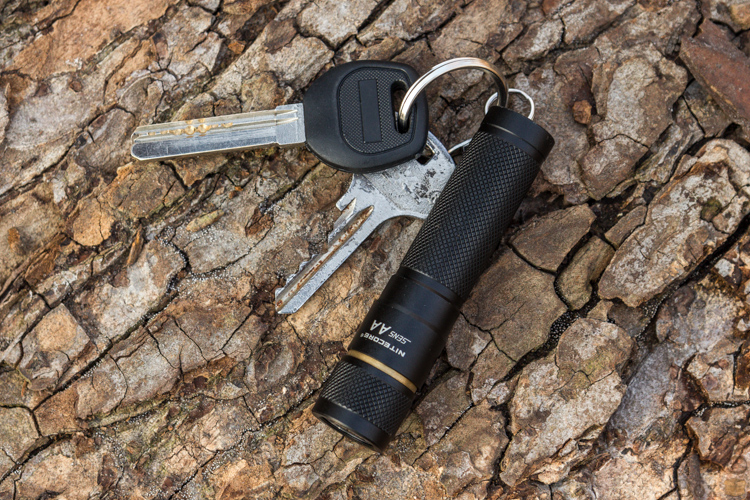
The device comes in a small yellow-black box, each side of which tells us to use the “same magic technology” ADT (Active Dimming Technology).

Inside - a standard set for most lamps from the device itself, instructions, a pair of rings (spare sealing and metal), instructions (Chinese, English) and a warranty card.

Actually, the lantern itself is made of black anodized aluminum. Build quality at the highest level. Nothing creaks and does not play. The manufacturer declared the possibility of immersion in water to a depth of 2 meters and resistance to falling from a height of 1.5 meters.
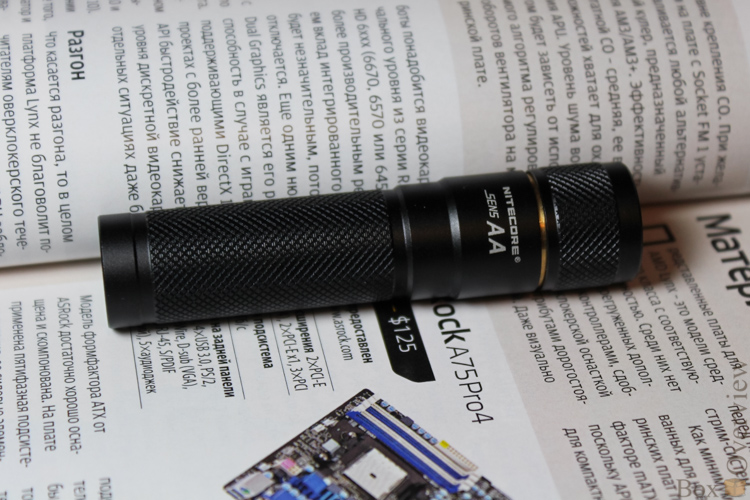
Physical dimensions: length - 81 mm, diameter of the “head” - 19.8 mm, case diameter - 17.5 mm. The lamp turns on by turning the head. Initially, the thread is “dry” and turning on the flashlight with one hand is quite problematic, so I lubricated it with LITOL-24. Of course, it is advisable to use specialized greases for flashlights (LITOL can make the sealing ring unusable if it is made of rubber), but then decide for yourself, I used what was at hand.

The weight of an incomplete flashlight is 26 grams (note, a NiMH battery has a weight of ~ 30 grams). Given only 2 keys on a bunch - the pocket does not delay.
Structurally, the flashlight consists of 2 parts: the "head" and the battery pack. The connection is threaded (small), a silicone O-ring is present to protect against moisture and dust.

At the bottom of the battery pack is a spring-loaded contact, which supposedly should prevent the battery from dangling inside the case. Whatever the case, the fact is that the Nitecore SENS AA battery compartment is made with a “margin” in diameter and when turned off, the battery rattles quite nasty inside it. You can fix this blunder, for example, by wrapping the battery with a piece of paper.

The head unit, despite its compact size, contains all the electronics and the actual operating element of the flashlight itself - an LED with an integrated lens (TIR optics). In our case, this is CREE XP-G (R5), where XP-G is the model of the LED, and R5 means the shade by which the diode shines. So R5 is a cool white shade. The lens is made of acrylic and slightly recessed deep into the body.

In the back of the "head" is installed protection against polarity reversal - a black rubber gasket, which in case of improper installation of the battery will prevent it from touching the power patch and shorting the circuit. There are 4 pins for flashing and debugging the microcontroller that controls the device.
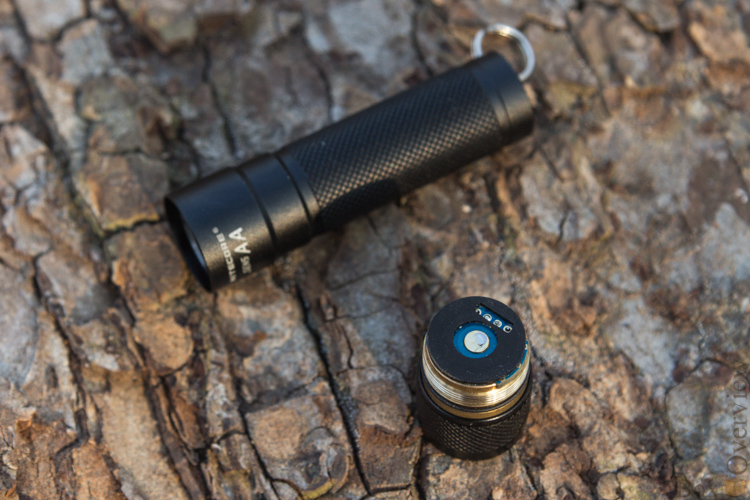
By the end of the second week of operation, the anodizing had worn off at the place where the lamp and the mounting ring came into contact. The rest of the case did not suffer any changes after a month of use.

Unfortunately, you cannot use Li-ion batteries of 14500 format with this flashlight (in fact, 3.2V LiFePO4 is possible, but not recommended). But I took this flashlight specifically for AA, since I have good stocks of nickel-metal hydride batteries of this size.

There are four operating modes and they are activated depending on the position of the lamp relative to the ground. Turning on the lamp in an upright position (head up) will activate the “smart” mode. In reality, the change in brightness is more obvious, especially when the lamp is head down.

There are also 3 fixed modes: LOW, MID, HIGH.
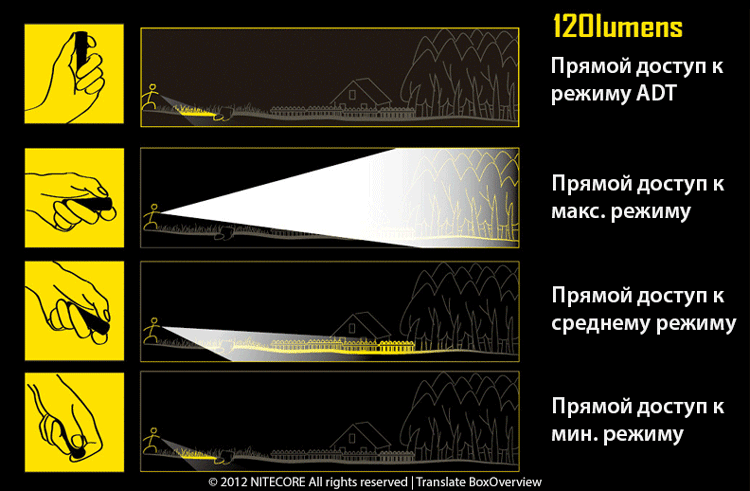
"For those who are in the subject" conducted measurements of current consumption in different modes. Just in case, every time I did 3 measurements, respectively, the average indicator is shown in the table. I didn’t perform any autonomy tests, I just put the battery on charge at the end of each month - this is enough.
LOW mode is activated by turning on the lamp in the vertical-down position. According to the manufacturer, in this mode, the brightness is set at 6 lumens, and the battery life will be 60 hours (when using a 1.2-2500 mAh Ni-Mh battery).

To activate the next mode (MID), the device must be turned on at an angle of 45 degrees to the ground. According to the passport in this mode, the brightness is set at 20 lumens, and the approximate operating time is 12 hours.
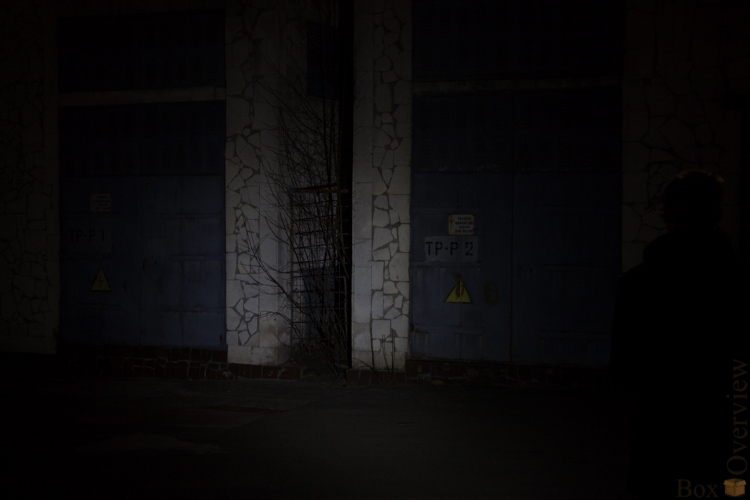
Well, the last, the brightest mode (HIGH). It is activated by turning on the lamp parallel to the ground (in fact, it is better to raise the degrees by 10, otherwise the lamp does not shine at full power). The instructions indicate that in HIGH mode the lamp will work for 2 hours at a brightness of 120 lumens.
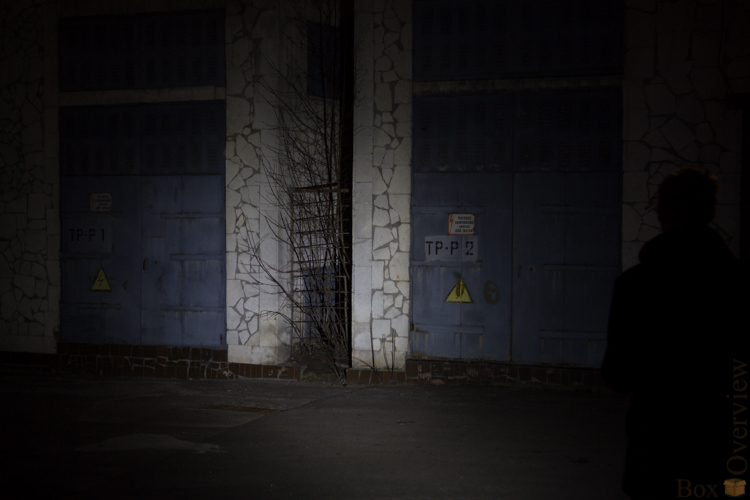
Excellent performance for such a baby, but do not forget that when using the "smart" mode, you need to take into account the current consumption of the control electronics (even if it is miserable). Unfortunately, it was not possible to find out what the latter is like. The printed circuit board is glued to the head unit with some kind of compound, so an attempt at preparation can result in very sad consequences for the flashlight.
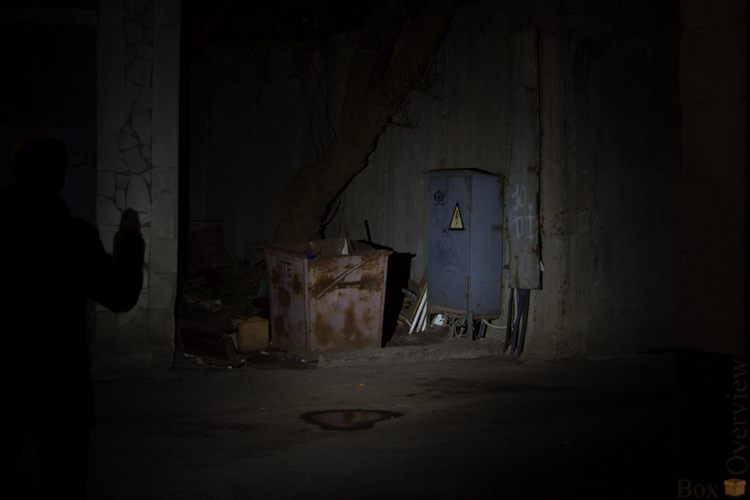
Summary
Nitecore SENS AA is an excellent device for the role of an everyday flashlight, which can also be used as a flashlight. The price in Chinese online stores is at the level of $ 25 (you can buy, for example, here ), in the CIS the price is on average $ 5 higher, but in this case, in the event of a breakdown, you simply replace the lamp with a new one (if the purchase was made from an authorized distributor).
Advantages and disadvantages
 Dust and moisture protection
Dust and moisture protection
 Compact dimensions
Compact dimensions
 Excellent light performance
Excellent light performance
 Smart mode (I really use it - an excellent feature)
Smart mode (I really use it - an excellent feature)
 Anodizing got off in the area of the key
Anodizing got off in the area of the key
 holder Initially, the taut course of the head part
holder Initially, the taut course of the head part
In general, the EDC theme is very extensive and no less interesting compared to electronic gadgets. Therefore, below is a survey of whether the audience of the habr has a desire to read more on this topic.
PS DIHALT Habrauser has recently been born a chic treatise on lanterns . Chewed all aspects of the work of such lamps and varieties thereof. I advise you to read.
I remind you that you can subscribe so as not to miss new reviews and articles on the company page(“subscribe” button), or on your favorite social network:
on the company page(“subscribe” button), or on your favorite social network:  Vkontakte , on
Vkontakte , on  Google + , on
Google + , on  Twitter
Twitter

The device comes in a small yellow-black box, each side of which tells us to use the “same magic technology” ADT (Active Dimming Technology).

Inside - a standard set for most lamps from the device itself, instructions, a pair of rings (spare sealing and metal), instructions (Chinese, English) and a warranty card.

Actually, the lantern itself is made of black anodized aluminum. Build quality at the highest level. Nothing creaks and does not play. The manufacturer declared the possibility of immersion in water to a depth of 2 meters and resistance to falling from a height of 1.5 meters.

Physical dimensions: length - 81 mm, diameter of the “head” - 19.8 mm, case diameter - 17.5 mm. The lamp turns on by turning the head. Initially, the thread is “dry” and turning on the flashlight with one hand is quite problematic, so I lubricated it with LITOL-24. Of course, it is advisable to use specialized greases for flashlights (LITOL can make the sealing ring unusable if it is made of rubber), but then decide for yourself, I used what was at hand.

The weight of an incomplete flashlight is 26 grams (note, a NiMH battery has a weight of ~ 30 grams). Given only 2 keys on a bunch - the pocket does not delay.
Structurally, the flashlight consists of 2 parts: the "head" and the battery pack. The connection is threaded (small), a silicone O-ring is present to protect against moisture and dust.

At the bottom of the battery pack is a spring-loaded contact, which supposedly should prevent the battery from dangling inside the case. Whatever the case, the fact is that the Nitecore SENS AA battery compartment is made with a “margin” in diameter and when turned off, the battery rattles quite nasty inside it. You can fix this blunder, for example, by wrapping the battery with a piece of paper.

The head unit, despite its compact size, contains all the electronics and the actual operating element of the flashlight itself - an LED with an integrated lens (TIR optics). In our case, this is CREE XP-G (R5), where XP-G is the model of the LED, and R5 means the shade by which the diode shines. So R5 is a cool white shade. The lens is made of acrylic and slightly recessed deep into the body.

In the back of the "head" is installed protection against polarity reversal - a black rubber gasket, which in case of improper installation of the battery will prevent it from touching the power patch and shorting the circuit. There are 4 pins for flashing and debugging the microcontroller that controls the device.

By the end of the second week of operation, the anodizing had worn off at the place where the lamp and the mounting ring came into contact. The rest of the case did not suffer any changes after a month of use.

Unfortunately, you cannot use Li-ion batteries of 14500 format with this flashlight (in fact, 3.2V LiFePO4 is possible, but not recommended). But I took this flashlight specifically for AA, since I have good stocks of nickel-metal hydride batteries of this size.

There are four operating modes and they are activated depending on the position of the lamp relative to the ground. Turning on the lamp in an upright position (head up) will activate the “smart” mode. In reality, the change in brightness is more obvious, especially when the lamp is head down.

There are also 3 fixed modes: LOW, MID, HIGH.

"For those who are in the subject" conducted measurements of current consumption in different modes. Just in case, every time I did 3 measurements, respectively, the average indicator is shown in the table. I didn’t perform any autonomy tests, I just put the battery on charge at the end of each month - this is enough.
| Mode | Consumption Current, mA |
|---|---|
| Low | 100 |
| MID | 200 |
| High | 1000 |

To activate the next mode (MID), the device must be turned on at an angle of 45 degrees to the ground. According to the passport in this mode, the brightness is set at 20 lumens, and the approximate operating time is 12 hours.

Well, the last, the brightest mode (HIGH). It is activated by turning on the lamp parallel to the ground (in fact, it is better to raise the degrees by 10, otherwise the lamp does not shine at full power). The instructions indicate that in HIGH mode the lamp will work for 2 hours at a brightness of 120 lumens.

Excellent performance for such a baby, but do not forget that when using the "smart" mode, you need to take into account the current consumption of the control electronics (even if it is miserable). Unfortunately, it was not possible to find out what the latter is like. The printed circuit board is glued to the head unit with some kind of compound, so an attempt at preparation can result in very sad consequences for the flashlight.

Summary
Nitecore SENS AA is an excellent device for the role of an everyday flashlight, which can also be used as a flashlight. The price in Chinese online stores is at the level of $ 25 (you can buy, for example, here ), in the CIS the price is on average $ 5 higher, but in this case, in the event of a breakdown, you simply replace the lamp with a new one (if the purchase was made from an authorized distributor).Advantages and disadvantages
 Dust and moisture protection
Dust and moisture protection  Compact dimensions
Compact dimensions  Excellent light performance
Excellent light performance  Smart mode (I really use it - an excellent feature)
Smart mode (I really use it - an excellent feature)  Anodizing got off in the area of the key
Anodizing got off in the area of the key  holder Initially, the taut course of the head part
holder Initially, the taut course of the head part In general, the EDC theme is very extensive and no less interesting compared to electronic gadgets. Therefore, below is a survey of whether the audience of the habr has a desire to read more on this topic.
PS DIHALT Habrauser has recently been born a chic treatise on lanterns . Chewed all aspects of the work of such lamps and varieties thereof. I advise you to read.
I remind you that you can subscribe so as not to miss new reviews and articles
 on the company page(“subscribe” button), or on your favorite social network:
on the company page(“subscribe” button), or on your favorite social network:  Vkontakte , on
Vkontakte , on  Google + , on
Google + , on  Twitter
TwitterOnly registered users can participate in the survey. Please come in.
